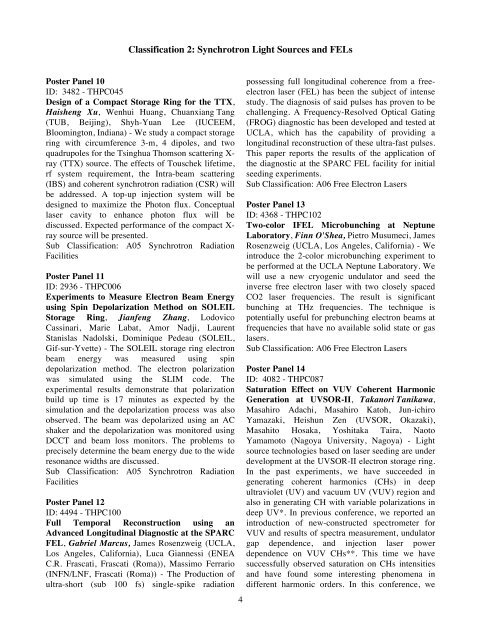Abstracts Brochure - 2nd International Particle Accelerator Conference
Abstracts Brochure - 2nd International Particle Accelerator Conference
Abstracts Brochure - 2nd International Particle Accelerator Conference
You also want an ePaper? Increase the reach of your titles
YUMPU automatically turns print PDFs into web optimized ePapers that Google loves.
�<br />
Classification 2: Synchrotron Light Sources and FELs<br />
Poster Panel 10<br />
ID: 3482 - THPC045<br />
Design of a Compact Storage Ring for the TTX,<br />
Haisheng Xu, Wenhui Huang, Chuanxiang Tang<br />
(TUB, Beijing), Shyh-Yuan Lee (IUCEEM,<br />
Bloomington, Indiana) - We study a compact storage<br />
ring with circumference 3-m, 4 dipoles, and two<br />
quadrupoles for the Tsinghua Thomson scattering Xray<br />
(TTX) source. The effects of Touschek lifetime,<br />
rf system requirement, the Intra-beam scattering<br />
(IBS) and coherent synchrotron radiation (CSR) will<br />
be addressed. A top-up injection system will be<br />
designed to maximize the Photon flux. Conceptual<br />
laser cavity to enhance photon flux will be<br />
discussed. Expected performance of the compact Xray<br />
source will be presented.<br />
Sub Classification: A05 Synchrotron Radiation<br />
Facilities<br />
Poster Panel 11<br />
ID: 2936 - THPC006<br />
Experiments to Measure Electron Beam Energy<br />
using Spin Depolarization Method on SOLEIL<br />
Storage Ring, Jianfeng Zhang, Lodovico<br />
Cassinari, Marie Labat, Amor Nadji, Laurent<br />
Stanislas Nadolski, Dominique Pedeau (SOLEIL,<br />
Gif-sur-Yvette) - The SOLEIL storage ring electron<br />
beam energy was measured using spin<br />
depolarization method. The electron polarization<br />
was simulated using the SLIM code. The<br />
experimental results demonstrate that polarization<br />
build up time is 17 minutes as expected by the<br />
simulation and the depolarization process was also<br />
observed. The beam was depolarized using an AC<br />
shaker and the depolarization was monitored using<br />
DCCT and beam loss monitors. The problems to<br />
precisely determine the beam energy due to the wide<br />
resonance widths are discussed.<br />
Sub Classification: A05 Synchrotron Radiation<br />
Facilities<br />
Poster Panel 12<br />
ID: 4494 - THPC100<br />
Full Temporal Reconstruction using an<br />
Advanced Longitudinal Diagnostic at the SPARC<br />
FEL, Gabriel Marcus, James Rosenzweig (UCLA,<br />
Los Angeles, California), Luca Giannessi (ENEA<br />
C.R. Frascati, Frascati (Roma)), Massimo Ferrario<br />
(INFN/LNF, Frascati (Roma)) - The Production of<br />
ultra-short (sub 100 fs) single-spike radiation<br />
4<br />
possessing full longitudinal coherence from a freeelectron<br />
laser (FEL) has been the subject of intense<br />
study. The diagnosis of said pulses has proven to be<br />
challenging. A Frequency-Resolved Optical Gating<br />
(FROG) diagnostic has been developed and tested at<br />
UCLA, which has the capability of providing a<br />
longitudinal reconstruction of these ultra-fast pulses.<br />
This paper reports the results of the application of<br />
the diagnostic at the SPARC FEL facility for initial<br />
seeding experiments.<br />
Sub Classification: A06 Free Electron Lasers<br />
Poster Panel 13<br />
ID: 4368 - THPC102<br />
Two-color IFEL Microbunching at Neptune<br />
Laboratory, Finn O'Shea, Pietro Musumeci, James<br />
Rosenzweig (UCLA, Los Angeles, California) - We<br />
introduce the 2-color microbunching experiment to<br />
be performed at the UCLA Neptune Laboratory. We<br />
will use a new cryogenic undulator and seed the<br />
inverse free electron laser with two closely spaced<br />
CO2 laser frequencies. The result is significant<br />
bunching at THz frequencies. The technique is<br />
potentially useful for prebunching electron beams at<br />
frequencies that have no available solid state or gas<br />
lasers.<br />
Sub Classification: A06 Free Electron Lasers<br />
Poster Panel 14<br />
ID: 4082 - THPC087<br />
Saturation Effect on VUV Coherent Harmonic<br />
Generation at UVSOR-II, Takanori Tanikawa,<br />
Masahiro Adachi, Masahiro Katoh, Jun-ichiro<br />
Yamazaki, Heishun Zen (UVSOR, Okazaki),<br />
Masahito Hosaka, Yoshitaka Taira, Naoto<br />
Yamamoto (Nagoya University, Nagoya) - Light<br />
source technologies based on laser seeding are under<br />
development at the UVSOR-II electron storage ring.<br />
In the past experiments, we have succeeded in<br />
generating coherent harmonics (CHs) in deep<br />
ultraviolet (UV) and vacuum UV (VUV) region and<br />
also in generating CH with variable polarizations in<br />
deep UV*. In previous conference, we reported an<br />
introduction of new-constructed spectrometer for<br />
VUV and results of spectra measurement, undulator<br />
gap dependence, and injection laser power<br />
dependence on VUV CHs**. This time we have<br />
successfully observed saturation on CHs intensities<br />
and have found some interesting phenomena in<br />
different harmonic orders. In this conference, we


